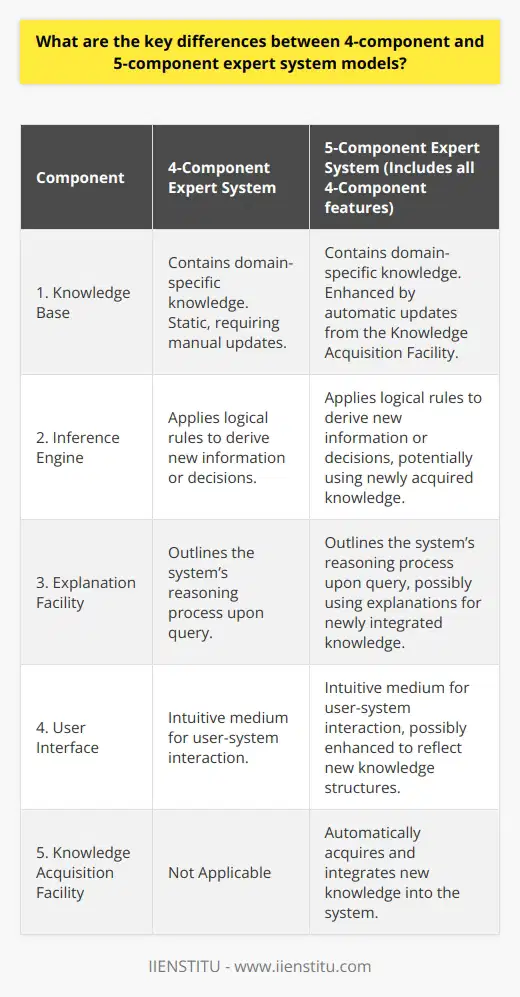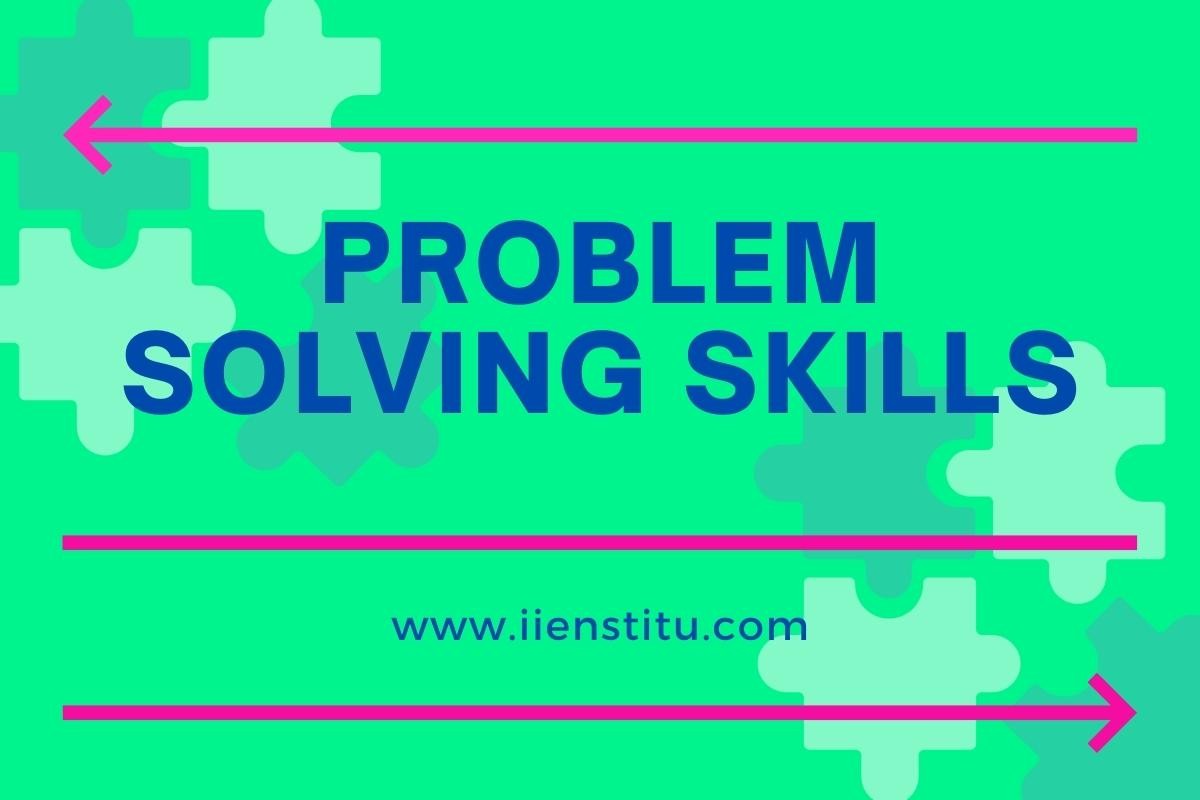
When I first stumbled upon the concept of expert systems during my computer science days, I was both fascinated and a tad skeptical. Could a machine really emulate the decision-making prowess of a human expert? It sounded like something straight out of a sci-fi movie! But as I delved deeper, I realized that expert systems are not just theoretical concepts—they're practical tools making significant impacts across various industries today.
Understanding Expert Systems: Bridging Human Expertise and AI
So, what exactly is an expert system? In simple terms, an expert system is a branch of artificial intelligence designed to solve complex problems by emulating the reasoning and decision-making abilities of a human expert. They're built on a foundation of specialized knowledge and are capable of processing vast amounts of information to provide solutions or recommendations in specific domains.
Introduction
What is an Expert System?
Examples of Expert Systems
How Does an Expert System Work?
Conclusion
Core Components of Expert Systems
An expert system typically consists of two main components:
1- Knowledge Base: This is the heart of the system, containing domain-specific facts, concepts, and rules gleaned from human experts. It's like the system's brain, filled with all the information it needs to make informed decisions.
2- Inference Engine: Think of this as the system's reasoning mechanism. It applies logical rules to the knowledge base to deduce new information or reach conclusions. The inference engine processes the input data and navigates through the knowledge base to provide outputs.
I recall working on a simple expert system project back in college. We attempted to create a system that could diagnose basic computer hardware issues. It was incredible to see the system suggest troubleshooting steps, almost as if a tech support agent was guiding us!
Real-World Examples of Expert Systems
Expert systems aren't just academic exercises; they're actively used in various fields:
IBM's Watson: Perhaps one of the most famous expert systems, Watson made headlines when it defeated two of the greatest Jeopardy! champions in 2011. Watson's ability to understand natural language and retrieve information rapidly showcased the immense potential of expert systems in handling complex queries. [^1]
MYCIN: Developed in the 1970s, MYCIN was an early expert system designed for medical diagnosis, specifically bacterial infections. It provided therapy recommendations based on patient data and had performance comparable to human experts. [^2]
DENDRAL: One of the first expert systems, DENDRAL was used for chemical analysis to assist in identifying molecular structures. It significantly sped up the process for chemists by analyzing mass spectrometry data. [^3]
PROSPECTOR: Used in geology, PROSPECTOR assisted in mineral exploration by evaluating the probability of finding mineral deposits in specific locations.
XCON: Also known as R1, it helped configure orders for computer systems, ensuring that components were compatible and met customer requirements.
Personal Experience: Implementing an Expert System in Retail
A few years ago, I was part of a team at a retail company facing challenges with inventory management. Stockouts and overstock situations were hurting our bottom line. We decided to implement an expert system to optimize our inventory levels. By analyzing sales data, seasonal trends, and supplier lead times, the system provided recommendations on reorder quantities and timing. It wasn't perfect at first—we had to tweak the knowledge base and adjust rules—but eventually, it led to a noticeable improvement in our inventory turnover rates.
Unlock your problem-solving skills with expert systems to open the door to success.
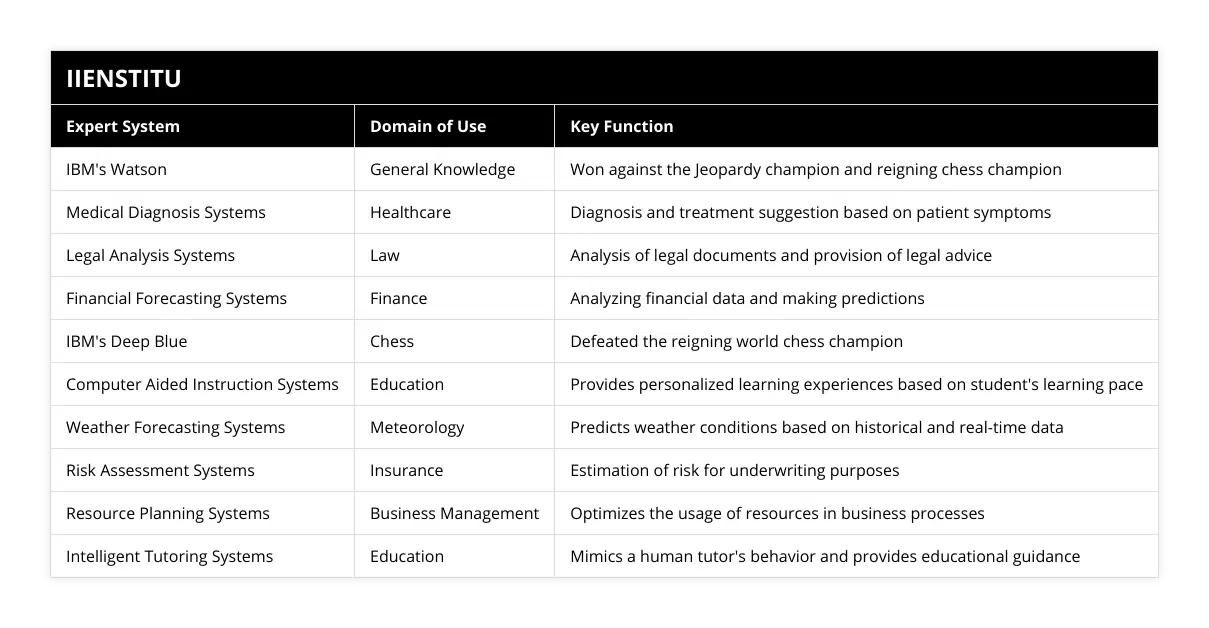
How Do Expert Systems Work?
Understanding the mechanics behind expert systems sheds light on their capabilities.
The Inference Engine: The System's Problem-Solver
The inference engine uses reasoning techniques to process information:
Forward Chaining: This approach starts with known facts and applies inference rules to extract more data until a goal is reached. It's data-driven reasoning.
Backward Chaining: This method starts with a list of goals or hypotheses and works backward to determine which facts support them. It's goal-driven reasoning.
Knowledge Acquisition: Feeding the System
One of the biggest challenges is knowledge acquisition—transferring expertise from human experts into the system. This often involves:
Interviews and Observations: Interacting with experts to understand their decision-making processes.
Documentation Review: Studying existing manuals, reports, and guidelines.
Rule Formulation: Converting expert knowledge into if-then rules that the system can use.
User Interface: Bridging System and User
A user-friendly interface is crucial. It allows users to input data and receive outputs effectively. Some systems even incorporate natural language processing, enabling more intuitive interactions.
Applications Across Various Fields
Expert systems have found their way into multiple domains, each leveraging the technology to address specific challenges.
Medical Diagnosis: Enhancing Healthcare Delivery
In the medical field, expert systems assist in:
Diagnosing Diseases: By inputting patient symptoms and test results, the system suggests potential diagnoses.
Recommending Treatments: Providing treatment options based on best practices and patient-specific factors.
Predicting Outcomes: Assessing risks and probable outcomes of different treatment plans.
For instance, expert systems have been instrumental in identifying rare diseases that may be overlooked. The benefits of using expert systems in healthcare include improved diagnostic accuracy and personalized patient care. [^4]
Legal Analysis: Navigating Complexities
In law:
Case Evaluation: Assessing the merits of legal cases based on precedents.
Contract Review: Analyzing contracts for potential issues or compliance gaps.
Compliance Monitoring: Ensuring that businesses adhere to regulations.
Legal expert systems reduce the time lawyers spend on research, allowing them to focus on strategy and client interaction.
Financial Forecasting: Informed Decision-Making
In the financial sector, expert systems:
Analyze Market Trends: Evaluating historical data to predict future market movements.
Optimize Portfolios: Suggesting investment strategies based on risk profiles.
Detect Fraud: Identifying unusual patterns that may indicate fraudulent activities.
These knowledge-based systems in financial analysis help institutions make data-driven decisions, enhancing profitability and compliance.
Business Management: Streamlining Operations
Surprisingly, expert systems can even aid in designing effective meeting agendas. By analyzing factors like participant availability, priorities, and past meeting outcomes, the system can suggest the best strategies for designing effective meeting agendas that maximize productivity. This ensures meetings are purposeful and time-efficient.
Manufacturing and Production
In manufacturing:
Process Control: Monitoring and adjusting production processes in real-time.
Quality Assurance: Detecting defects and suggesting corrective actions.
Maintenance Scheduling: Predicting equipment failures and scheduling preventive maintenance.
Advantages and Limitations of Expert Systems
Advantages
Consistency: They provide uniform solutions without the variability inherent in human decision-making.
Speed: Capable of processing information much faster than humans.
Availability: Expert systems are available 24/7, without the constraints of human working hours.
Knowledge Preservation: They retain expert knowledge, which is invaluable when experts retire or leave.
Limitations
Lack of Common Sense: They operate strictly within their programmed knowledge base and cannot handle situations outside their domain.
Dependence on Quality of Input: Incorrect or incomplete data can lead to erroneous outputs.
Maintenance Challenges: Keeping the knowledge base updated requires ongoing effort.
Implementation Challenges of Expert Systems: Developing and integrating expert systems can be costly and time-consuming.
The Future of Expert Systems
As technology evolves, so does the potential of expert systems.
Integration with Machine Learning
Combining expert systems with machine learning allows for:
Adaptive Learning: Systems that can learn from new data and improve over time.
Enhanced Decision-Making: Using patterns and predictions to augment rule-based reasoning.
Expansion into New Domains
With advancements in natural language processing and data analytics, expert systems are poised to enter fields previously thought unsuitable.
Expert Systems vs. Traditional Problem-Solving Methods
Traditional problem-solving often relies on human intuition and experience, which, while valuable, can be subjective and inconsistent. Expert systems provide a structured and consistent approach, reducing errors and biases.
The Role of Expert Systems in Decision Making
Expert systems assist decision-makers by:
Providing Evidence-Based Recommendations: Grounded in data and best practices.
Identifying Potential Risks: Highlighting areas of concern that may not be immediately apparent.
Enhancing Efficiency: Streamlining the decision-making process by quickly processing information.
Tips for Successfully Implementing Expert Systems
From my experiences, here are some key pointers:
1- Start with a Clear Objective: Identify the specific problem you want the system to address.
2- Involve Stakeholders Early: Engage experts and end-users from the beginning to ensure the system meets their needs.
3- Focus on Quality Knowledge Acquisition: The system is only as good as the knowledge it contains.
4- Plan for Ongoing Maintenance: Establish processes for updating the knowledge base.
5- Evaluate and Iterate: Regularly assess the system's performance and make necessary adjustments.
Reflecting on the Journey
Looking back, it's remarkable how far expert systems have come. From early projects diagnosing plant diseases to sophisticated systems like IBM's Watson, the evolution has been astounding. They've proven their worth across various industries, and their potential continues to grow.
But perhaps what's most exciting is how expert systems and artificial intelligence are shaping the future. They're not replacing human experts but augmenting our capabilities, allowing us to solve problems more efficiently and effectively.
Conclusion
Expert systems represent a fusion of human expertise and artificial intelligence, offering solutions that enhance decision-making across numerous fields. Whether it's in healthcare, finance, law, or even organizing meetings more effectively, these systems have demonstrated their value.
As we embrace the future, the role of expert systems in decision making will likely expand, offering even more sophisticated tools to tackle complex challenges. By leveraging these technologies thoughtfully, we can unlock new levels of efficiency and innovation.
References
[^1]: Ferrucci, D., Brown, E., Chu-Carroll, J., Fan, J., Gondek, D., et al. (2010). Building Watson: An Overview of the DeepQA Project. AI Magazine, 31(3), 59-79.
[^2]: Shortliffe, E. H. (1976). Computer-Based Medical Consultations: MYCIN. American Elsevier.
[^3]: Buchanan, B. G., & Feigenbaum, E. A. (1978). DENDRAL and Meta-DENDRAL: Their Applications Dimension. Artificial Intelligence, 11(1-2), 5-24.
[^4]: Miller, R. A. (1994). Medical Diagnostic Decision Support Systems—Past, Present, and Future: A Threaded Bibliography and Brief Commentary. Journal of the American Medical Informatics Association, 1(1), 8-27.
Well, that's my take on expert systems! They're not without their challenges, but the possibilities they offer are truly exciting. After all, combining human expertise with artificial intelligence might just be the key to unlocking solutions we've yet to imagine.
Frequently Asked Questions
What are the benefits of using an Expert System to unlock problem solving skills?
Expert systems are becoming increasingly popular as a means by which to unlock problem-solving skills. An expert system is a computer program that uses artificial intelligence techniques to simulate the decision-making abilities of an expert in a specific field or task. The primary benefit of using an expert system to unlock problem-solving skills is that it provides an efficient and cost-effective solution to complex problems. By utilizing an expert system, an individual or organization can obtain the same results as if they had hired an expert in the specific field.
Using an expert system allows for greater accuracy and consistency in problem-solving, as the system can provide a more comprehensive analysis of a problem, taking into account a variety of variables. Furthermore, an expert system allows for a faster and more efficient solution to a problem. This can be particularly beneficial when a quick response is needed, such as in medical emergencies or when a complex decision needs to be made.
Using an expert system also provides access to a broader range of problem-solving techniques. By combining an expert system with other forms of artificial intelligence, such as fuzzy logic and neural networks, it is possible to create more sophisticated problem-solving solutions. This can provide a much more effective solution to complex problems.
Finally, an expert system can provide access to a larger pool of problem-solving skills. By accessing a broader range of problem-solving techniques, an individual or organization can achieve a more comprehensive and accurate solution to a problem. This can be particularly beneficial when problem-solving skills, such as in the medical field, are essential.
In conclusion, using an expert system to unlock problem-solving skills has many benefits. It is an efficient and cost-effective solution to complex problems and provides access to a broader range of problem-solving techniques. Furthermore, it can provide access to a larger pool of problem-solving skills and can provide an accurate and consistent solution to a problem. Therefore, it is clear why using an expert system to unlock problem-solving skills is an increasingly popular choice.
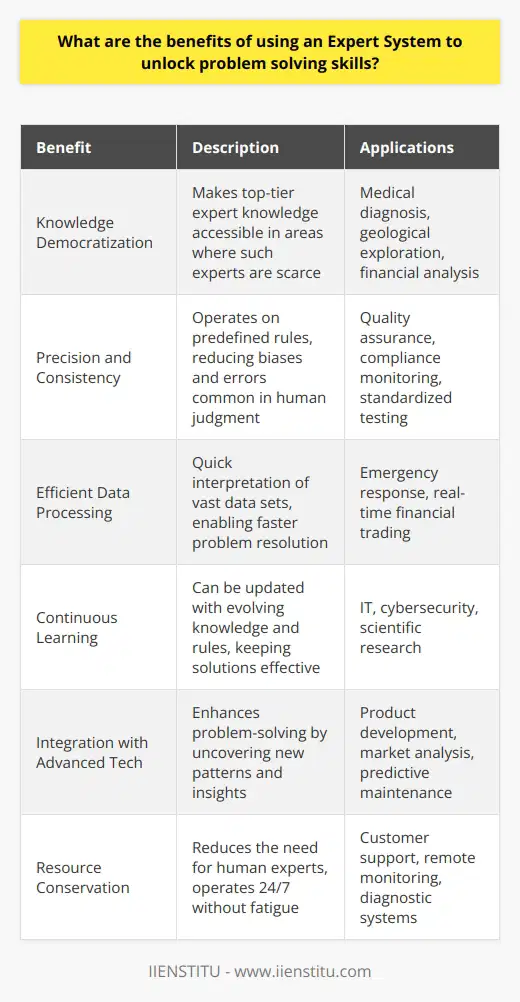
How can an Expert System be used to improve decision making?
Expert systems are computer software applications designed to emulate the decision-making capabilities of a human expert. These systems combine artificial intelligence, knowledge engineering, and advanced analysis techniques to provide automated, data-driven decisions. By leveraging the power of expert systems, organizations can make decisions more quickly, accurately, and consistently than ever before.
The use of expert systems in decision-making has grown significantly in recent years. This is because organizations now have access to vast amounts of data and a variety of decision-making techniques, such as predictive analytics. By leveraging these capabilities, organizations can make decisions in a much more informed and accurate way than ever before.
In order to take advantage of the power of expert systems, organizations must first develop a comprehensive knowledge base. This includes gathering information from various sources, such as customer feedback, market research, and industry surveys. This knowledge base will then be used to inform the development of the expert system.
Once the expert system is developed, organizations can use it to improve decision-making. For example, expert systems can be used to identify trends, analyze customer behavior, and make predictions about future customer needs. By leveraging the data and insights provided by the expert system, organizations can make more informed and accurate decisions. Additionally, organizations can use the system to automate certain aspects of decision-making, such as creating customer segments or generating customer recommendations.
Finally, organizations can use expert systems to monitor and track the results of their decisions. This allows them to assess the effectiveness of the decisions and make adjustments as needed. By using expert systems to monitor and track the results of their decisions, organizations can ensure that they are taking the proper steps to improve their decision-making processes.
Overall, expert systems are a powerful tool for improving decision-making. By leveraging the data and insights provided by the expert system, organizations can make more informed and accurate decisions. Additionally, organizations can use the system to automate certain aspects of decision-making, such as creating customer segments or generating customer recommendations. Finally, organizations can use expert systems to monitor and track the results of their decisions, ensuring that they are taking the proper steps to improve their decision-making processes.
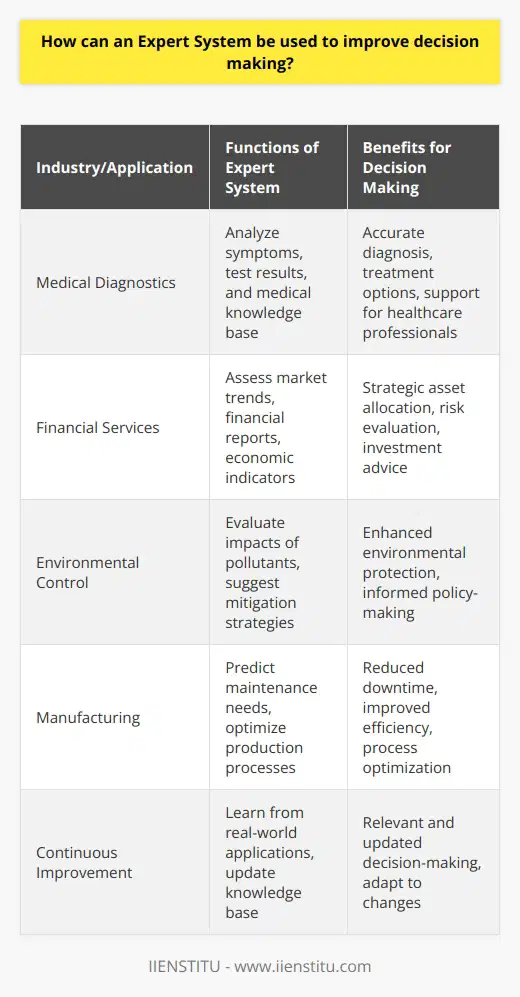
What are the potential drawbacks of using an Expert System to solve problems?
Expert systems can be a great asset when it comes to solving complex problems. Expert systems are artificial intelligence (AI) programs that use knowledge and reasoning to solve complex problems. However, while these systems can be beneficial in some scenarios, there are potential drawbacks that must be considered before using them.
One of the main drawbacks of using expert systems is the cost. Expert systems require significant hardware and software investment and skilled personnel to develop and maintain them. Depending on the complexity of the problem being solved, the cost of developing an expert system can be prohibitive.
Another potential drawback of using expert systems is their need for more flexibility. Expert systems are typically designed to solve specific problems and cannot adapt to new scenarios or changing conditions. This can be a significant limitation when the problem being solved is highly dynamic.
In addition, expert systems can be limited by their need for more contextual understanding. Expert systems are based on raw data, which means they cannot interpret subtle cues or the meaning of words. This can lead to inaccurate results, as the system needs to recognize the nuances of the problem.
Finally, expert systems are vulnerable to errors and bias. Expert systems are only as accurate as the data and assumptions used to create them. If the data is complete and accurate, or if the assumptions are flawed, the system will produce correct results. Additionally, the system may be biased if the data is skewed in a particular direction.
In conclusion, while expert systems can be a valuable tool in some scenarios, they also have potential drawbacks that must be considered. For example, expert systems can be expensive to develop and maintain, lack flexibility, lack contextual understanding, and are vulnerable to errors and bias. For these reasons, it is essential to consider the potential drawbacks before using an expert system to solve complex problems.
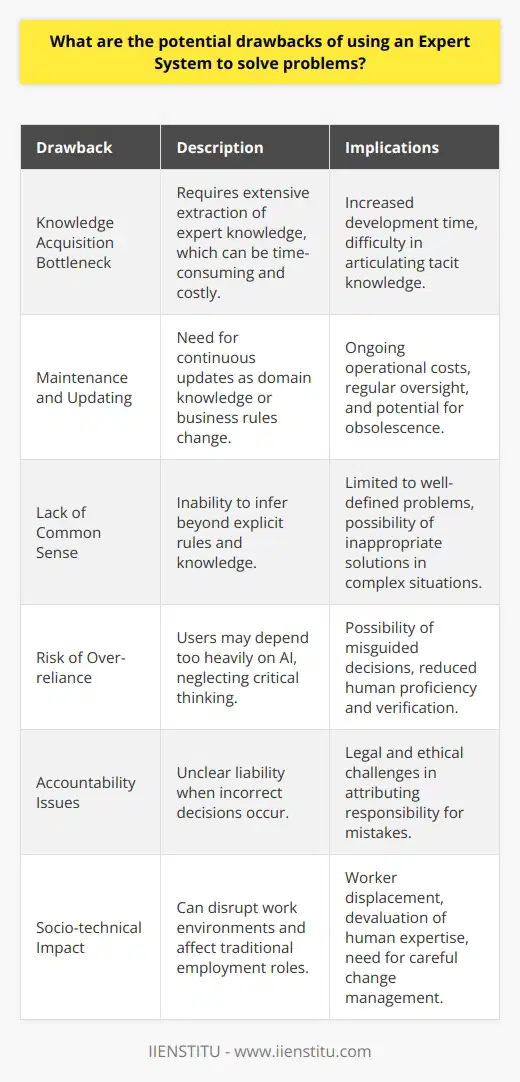
How do expert systems contribute to enhancing difficult problem-solving techniques?
Expert Systems Promote Efficiency
Expert systems, which are artificial intelligence-based software programs, provide valuable assistance in solving complex problems. By incorporating human expertise and knowledge into their design, these systems play a crucial role in enhancing difficult problem-solving techniques.
Increased Accuracy and Speed
One key contribution of expert systems is their ability to perform tasks with greater precision and speed than humans. Through the use of algorithms and data analysis, these systems can process vast amounts of information in a fraction of the time it would take a person. This efficiency allows for quicker solutions and improved decision making.
Adaptability and Learning
Expert systems are also capable of adapting to changing circumstances and learning from new information. This adaptability allows them to continuously improve and evolve their problem-solving strategies. As a result, they can tackle increasingly complex problems and remain relevant in dynamic environments.
Reducing Cognitive Load
By relieving humans of time-consuming tasks, expert systems also reduce the cognitive load on their users. This allows individuals to focus on more strategic aspects of problem-solving, fostering innovation and creativity. The collaborative nature of expert systems ensures that human input remains valuable, enhancing the overall effectiveness of the problem-solving process.
Guided Decision Making
Another advantage of expert systems is their ability to provide guided decision making. Using the expert knowledge embedded in their programming, these systems can offer suggestions, identify risks, and highlight potential solutions for users to consider. This guidance allows for more informed decision making and improved problem-solving outcomes.
In summary, expert systems contribute significantly to enhancing difficult problem-solving techniques by providing increased accuracy, adaptability, reduced cognitive load, and guided decision making. Their ability to process and analyze large amounts of data efficiently, while also learning and adapting to new information, makes them an invaluable tool in tackling complex problems. By complementing human expertise, expert systems enable more effective and innovative solutions.
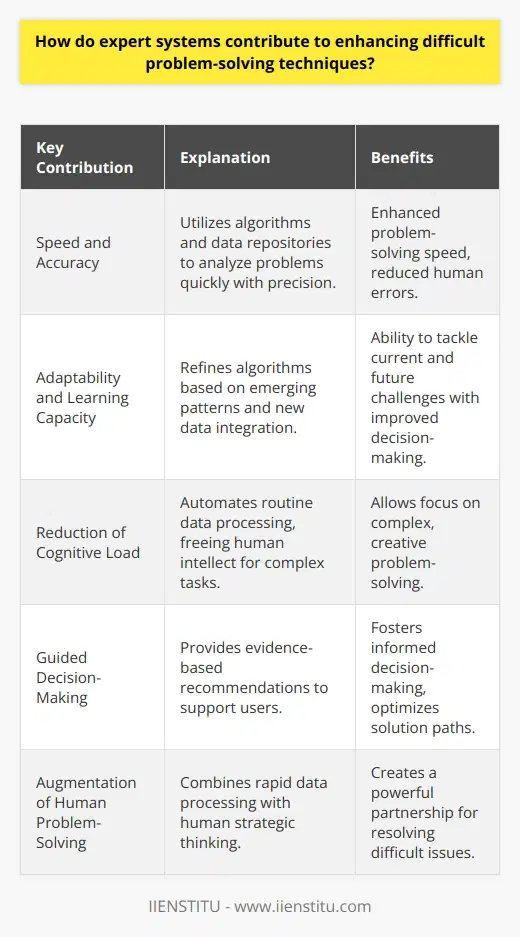
In what ways can one develop a proficiency in problem-solving using expert systems?
Understanding Expert Systems
To develop proficiency in problem-solving using expert systems, one must first understand their nature and capabilities. Expert systems are a type of artificial intelligence technology that uses knowledge from domain experts to imitate human reasoning and decision-making. Generally, these systems can analyze complex scenarios, evaluate potential solutions, and recommend the best course of action based on the available data and insights.
Acquiring Domain Knowledge
A crucial aspect of mastering expert systems is acquiring knowledge in the specific domain of interest. One can achieve this by studying relevant literature, attending workshops, and engaging in discussions with domain experts. A solid foundation in the field allows one to utilize expert systems effectively and ensures meaningful input and output for problem-solving tasks.
Selecting Appropriate Tools
Next, it is essential to familiarize oneself with the available expert system tools and platforms. Some popular expert system tools include CLIPS, JESS, and Drools, which vary in terms of programming languages, ease of use, and capabilities. Comparing these tools and choosing the one that best suits the individual's needs paves the way for efficient problem-solving strategies.
Developing Rules and Heuristics
One of the distinctive features of expert systems is the use of rules and heuristics to deduce potential solutions. Becoming proficient in problem-solving with expert systems requires the ability to develop relevant rules accurately representing the domain and incorporating expert knowledge. Practicing and refining rule-writing skills can lead to more effective and efficient expert system implementations.
Evaluating and Refining Solutions
Lastly, effective problem-solving using expert systems involves a continuous process of evaluation and refinement. Users should regularly evaluate the solutions generated by expert systems for accuracy, relevance, and feasibility. This assessment may require consulting domain experts or performing additional research. Such evaluation and iterative refinement help improve the system's performance, ensuring proficiency in problem-solving with expert systems.
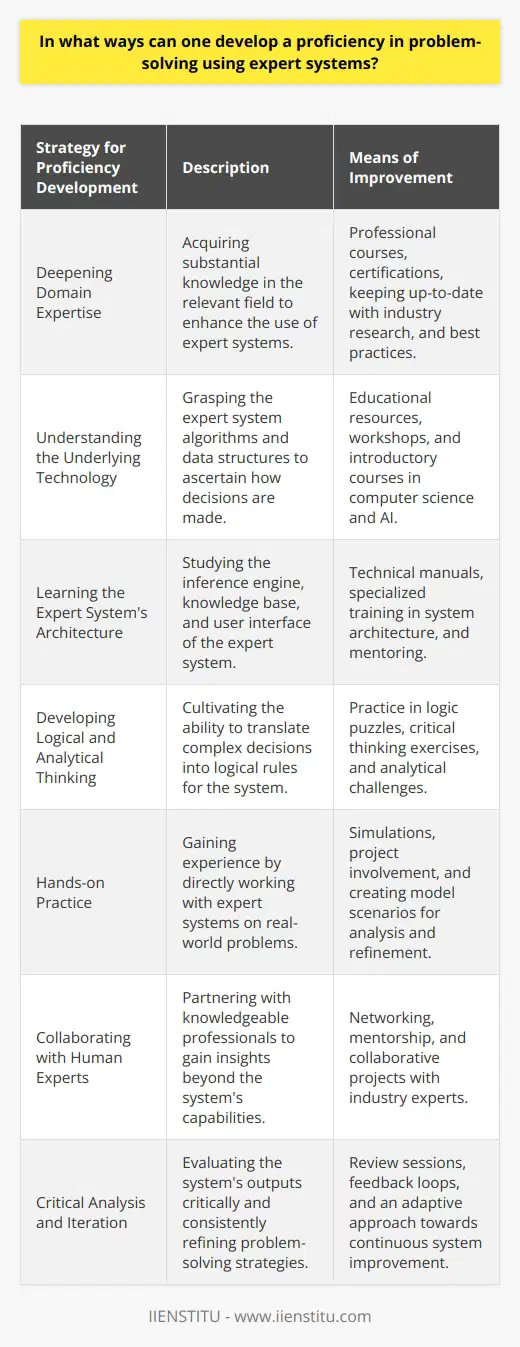
Which categories of problems are more effectively addressed through the application of expert systems?
Expert Systems in Decision-Making
One category of problems expert systems address effectively is decision-making under uncertainty. Expert systems are computer programs that use artificial intelligence (AI) techniques to simulate the reasoning process of a human expert. They are capable of processing and analyzing large amounts of data, identifying patterns in that data, and drawing conclusions based on that analysis.
Diagnosis and Troubleshooting
Another area where expert systems excel is in the diagnosis and troubleshooting of complex systems. In sectors such as healthcare and IT, expert systems offer valuable guidance by providing efficient diagnostic procedures and suggesting appropriate solutions. By emulating human expert reasoning in these areas, expert systems reduce the time and effort required to determine the root cause of a problem and recommend the most suitable course of action.
Optimization in Planning and Scheduling
Expert systems are instrumental in optimizing planning and scheduling processes across industries such as manufacturing, logistics, and project management. Through the application of heuristic search algorithms and constraint satisfaction techniques, expert systems can quickly explore different possible scenarios, identifying optimal resource allocation and time management strategies. These systems significantly enhance the efficiency and effectiveness of the planning process, leading to increased productivity and cost savings.
Financial Analysis and Forecasting
In finance and economics, expert systems are effectively used for data analysis, trend identification, and forecasting. By analyzing historical data, expert systems can identify patterns and correlations crucial for investment and operational decision-making. Additionally, expert systems can perform simulations and generate predictive models, aiding in the anticipation of market trends and risks, and informing the formulation of appropriate strategies.
Conclusion
Expert systems are highly valuable in addressing problems characterized by complexity, abundance of data, or uncertainty. While not a comprehensive list, the categories of decision-making under uncertainty, diagnosis and troubleshooting, optimization in planning and scheduling, and financial analysis and forecasting all benefit extensively from the application of expert systems. These problem domains greatly benefit from the efficiency and effectiveness expert systems offer, leading to better decision-making and the overall improvement of operational performance.
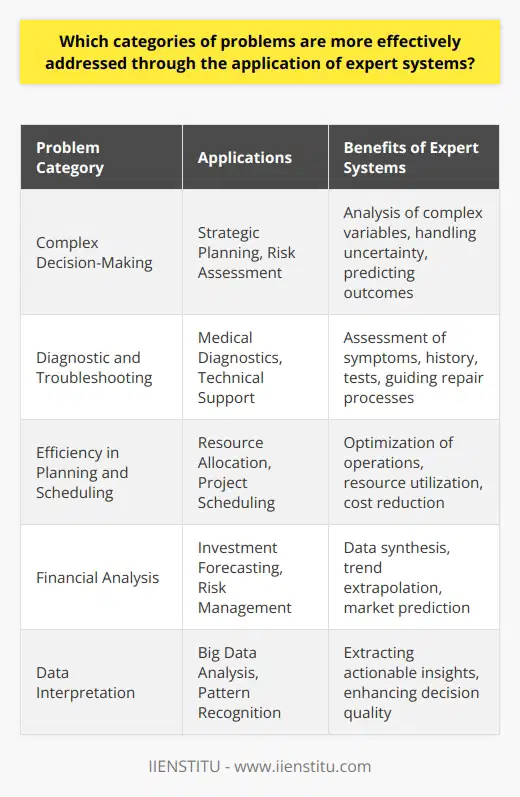
How are expert systems useful for knowledge intensive problems?
Expert Systems in Knowledge Intensive Problems
As technological advancements continue to influence numerous aspects of our lives, expert systems play a critical role in solving knowledge-intensive problems. Crucial to addressing complex issues, these intelligent programs demonstrate their efficacy through their unique features and capabilities.
Inherent Knowledge Representation
Expert systems enable the representation of vast amounts of knowledge, allowing for efficient and comprehensive problem-solving. The integration of rule-based, case-based, or hybrid systems encourages flexibility in addressing intricate challenges faced within various fields.
Facilitating Decision-Making Process
One of the notable benefits of expert systems is their enhancement of the decision-making process. By automating reasoning and applying logical reasoning principles, they generate effective solutions and minimize human errors or biases that could potentially interfere with problem-solving.
Coping with Uncertain and Incomplete Data
Expert systems have the ability to work with uncertain and incomplete data. They employ probability and fuzzy logic techniques to provide valuable insights and rational solutions, even when sufficient information is unavailable.
Learning and Adaptability
The incorporation of advanced learning algorithms, such as artificial neural networks and genetic algorithms, empowers expert systems to adapt and refine their problem-solving strategies. The constant optimization of knowledge and techniques enables these systems to remain relevant and efficient in ever-evolving environments.
Collaboration with Human Experts
Complementing human expertise is another advantage of expert systems. By collaborating with professionals and incorporating their knowledge in the problem-solving process, the system strengthens the reliability and accuracy of the generated solutions.
Transferability and Consistency
Expert systems ensure the consistent application of knowledge and best practices across various problem domains. This widespread application ensures that actionable solutions are transferable, promoting uniformity and cohesion amongst professionals and organizations worldwide.
In conclusion, expert systems have proven to be an invaluable tool in addressing knowledge-intensive problems. By encapsulating extensive knowledge, enhancing decision-making, embracing uncertainty, learning from experience, and facilitating collaboration, these intelligent programs promote better problem-solving strategies in various fields worldwide.
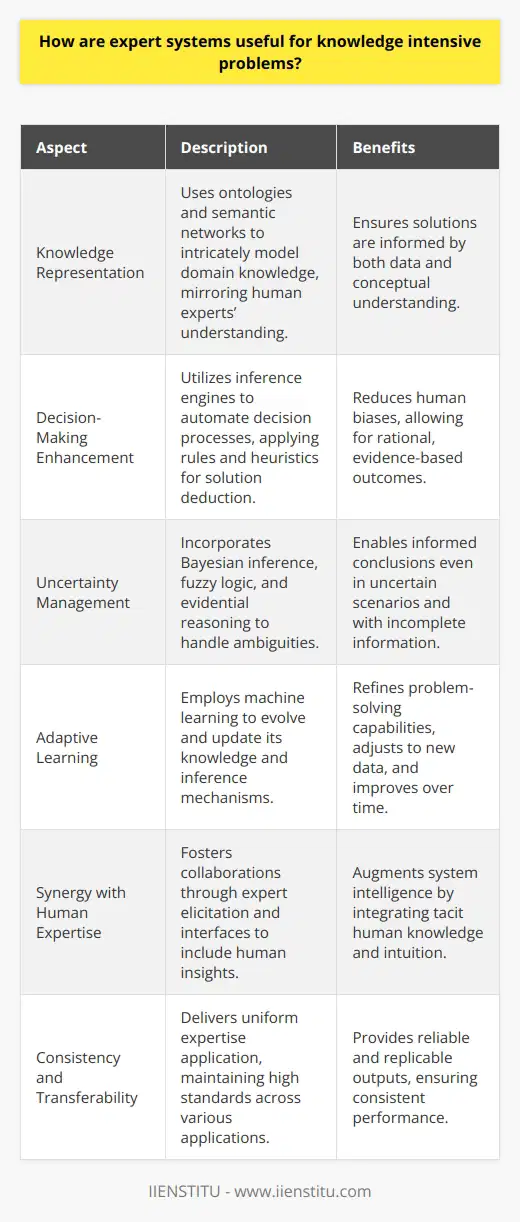
What are the 4 components of an expert system?
Components of Expert Systems
In the field of artificial intelligence, an expert system refers to a computer program designed for solving problems that require human expertise. An expert system traditionally consists of four primary components, which contribute to its overall functioning in problem-solving and decision-making. They are the knowledge base, the inference engine, the user interface, and the explanation subsystem.
Knowledge Base
The knowledge base is the central component of an expert system, as it stores the specialized knowledge gathered from experts. This includes facts, rules, procedures, concepts, and heuristics that allow the system to mimic human reasoning when analyzing a given problem. The representation of knowledge in the knowledge base can be in various forms, such as production rules, semantic networks, or frames.
Inference Engine
The inference engine is the component responsible for applying reasoning techniques to the knowledge base, in order to derive conclusions or make decisions. It essentially manipulates the data stored in the knowledge base by following logical rules, making inferences, and applying problem-solving strategies. The inference engine can utilize different reasoning methods, such as forward chaining, backward chaining, or a combination of both.
User Interface
The user interface in an expert system serves as a medium of communication between the end-users (e.g., human decision-makers) and the system. It enables users to input queries or present problems and receive solutions or recommendations from the system. Moreover, the user interface should be user-friendly and simple to operate, facilitating a seamless interaction experience for the users.
Explanation Subsystem
Lastly, the explanation subsystem provides users with a detailed explanation or justification for the conclusions derived by the expert system. It helps in understanding how the system arrived at a particular solution, which is crucial for user trust and acceptance. To enhance transparency, the explanation subsystem must present information in a comprehensible manner, allowing users to evaluate the reasoning process and validity of the outcomes.
Conclusively, an expert system's efficacy in problem-solving relies on the interplay of these four components. The knowledge base houses the domain-specific knowledge while the inference engine applies reasoning to deduce conclusions. All the while, the user interface facilitates communication, and the explanation subsystem transparently justifies the generated recommendations.
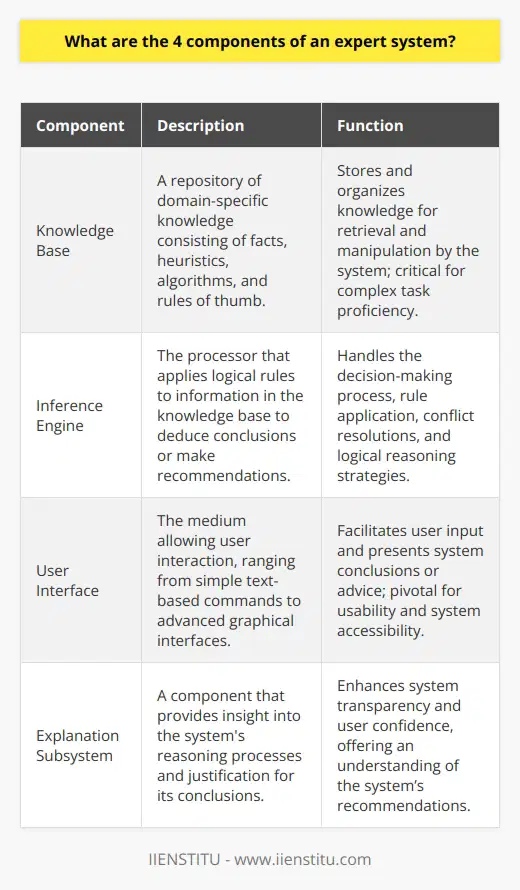
What two strategies are commonly used in expert systems to address complex issues?
**Rule-Based Approach**
One prevalent strategy employed in expert systems to tackle intricate challenges is the rule-based approach. In this methodology, knowledge is represented as a collection of rules that define various relationships between pieces of information. These rules often take the form of IF-THEN statements and establish direct links between the problem's antecedents and their consequences. By employing an inference engine, the system can draw logical conclusions from the provided rules, enabling efficient decision-making and problem-solving capabilities.
For example, in a medical diagnosis expert system, the rules can define how different symptoms may indicate specific illnesses. When presented with a patient's symptoms, the system would then evaluate these rules and deduce potential diagnoses based on the observed relationships.
**Case-Based Reasoning**
Another common strategy that expert systems utilize in addressing multifaceted concerns is case-based reasoning (CBR). Unlike the rule-based approach, CBR relies on learning from the past experiences, or cases, to solve new problems. When confronted with a complex issue, the system searches for similar cases from its stored knowledge base and evaluates their solutions. It then adapts these resolutions to fit the current scenario, providing a plausible solution tailored to the unique circumstances.
For instance, a CBR-based expert system for legal matters might have a database of previous court cases with information about their outcomes. When asked to predict the verdict for a new case, it would identify analogous instances and modify their relevant aspects to create an appropriate recommendation.
**Conclusion**
In conclusion, expert systems frequently employ the rule-based approach and case-based reasoning strategies to tackle complex issues. Both methods offer distinct advantages and enable the system to draw from a wealth of past experiences and established relationships. These strategies allow expert systems to efficiently provide accurate solutions and help users make well-informed decisions in various domains.
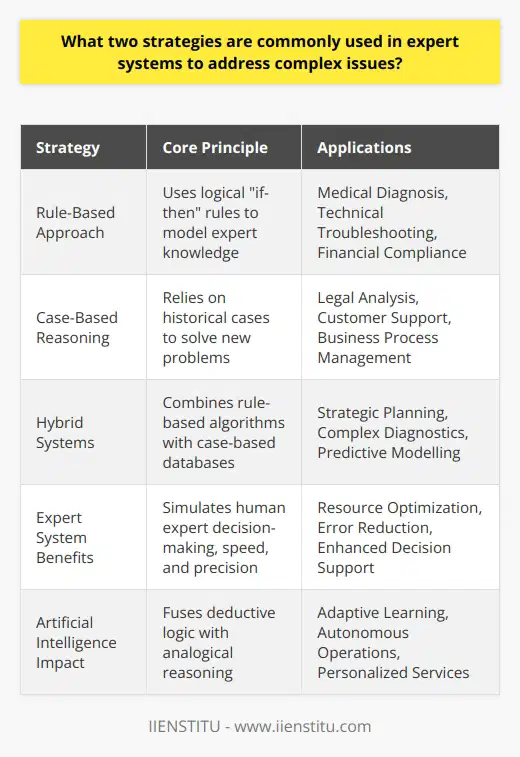
How can an expert system solve a problem?
Understanding Expert Systems
An expert system is a type of artificial intelligence. It aims to solve complex problems by emulating the decision-making ability of a human expert. They function by using knowledge-based computing techniques.
Gaining Knowledge
The first step is knowledge acquisition. The system needs to gather and organize a large amount of domain-specific information. This is usually done by interviewing subject matter experts and consolidating their insights.
Incorporating Inference Engine
Next, the system develops an inference engine. This applies logical rules to the knowledge base in order to draw conclusions. The engine emulates human reasoning, making logical deductions based on the data it has.
Rule-Based Reasoning
Rule-based reasoning is a common feature in these systems. It involves if-then rules, leading to a decision or solution. The system uses these rules to infer a conclusion from given facts, using logical deduction processes.
Dealing with Uncertainty
The system can also deal with uncertainty. It uses different techniques like fuzzy logic and probability theory. These enable the system to operate even when information is incomplete or ambiguous, delivering the best possible solution.
User Interface
Finally, an expert system communicates its findings through a user interface. The information is presented in a comprehensible way, ensuring users can understand and make use of the conclusions drawn.
Solution Implementation
When a problem arises, the expert system applies rules to the knowledge base. In doing so, it generates and evaluates all possible solutions. The system then suggests the most suitable solution satisfying all the given conditions.
So, in brief, an expert system can solve problems by simulating human decision-making and reasoning. They derive conclusions from vast amounts of data, ensuring highly-informed and dependable solutions.

What are the essential characteristics for an individual to become an expert problem solver in the context of expert systems?
Understanding Expert Systems
An essential characteristic for an individual in the context of expert systems is a thorough understanding of the domain. They should possess deep knowledge of the field even to the minute details that can aid in problem-solving.
Analytical Skills and Deductive Reasoning
Next, strong analytical skills are fundamental. Such individuals need the ability to dissect complex problems, inspect the components, and identify the root cause. Additionally, their deductive reasoning skills should be top-notch to draw necessary conclusions from the information in hand.
Problem-solving Abilities
Problem-solving skills are inevitable. The individual must approach problems innovatively and must have a strategic approach in attacking issues with a solution-focused mindset.
Experience and Continuous Learning
Years of experience in a relevant domain can mold an expert problem solver. However, it doesn't stop there. They must engage in continuous learning, updating their subject matter expertise with the latest research findings and technology advancements.
Knowledge in Artificial Intelligence
Working with expert systems also necessitates a grasp of artificial intelligence (AI). AI forms the foundation of these systems, hence understanding its functionalities enables effective problem solving.
Teamwork and Communication
Lastly, teamwork and good communication skills play an integral role for an individual dealing with expert systems. They must collaborate with other experts and stakeholders for insight and communicate their findings effectively.
In conclusion, expertise in the specific domain, analytical and problem-solving skills accompanied by continuous learning, AI knowledge, and excellent teamwork and communication abilities are the vital characteristics of an expert problem solver in the context of expert systems.

What are the key differences between 4-component and 5-component expert system models?
Expert System Models: A Comparison
4-component and 5-component expert system models share some common features but also have key differences.
Components in 4-Component Model
The 4-component model of expert systems consists of knowledge base, inference engine, explanation facility, and user interface. The first component, knowledge base, stores the expert knowledge. The second component, inference engine, applies rules to the knowledge base to draw conclusions.
Explanation Facility and User Interface
The third component, explanation facility, explains how the system arrived at a particular conclusion. The final component is the user interface. The user interface allows humans to interact with the system.
Additional Component in 5-Component Model
On the other hand, a 5-component expert system model includes an additional component, the knowledge acquisition facility. This 5th component facilitates the acquisition, validation, integration, and refinement of the knowledge stored in the system.
Role of Knowledge Acquisition Facility
The knowledge acquisition facility is essential in maintaining the dynamism of an expert system. It allows the system to learn and evolve over time by acquiring new knowledge. Moreover, it streamlines the process of incorporating expert knowledge into the system, making it more efficient.
In conclusion, 4-component models host the same features but lack the feature of knowledge acquisition that is present in 5-component models. This added feature allows 5-component expert systems to learn, evolve and incorporate new knowledge more efficiently.
